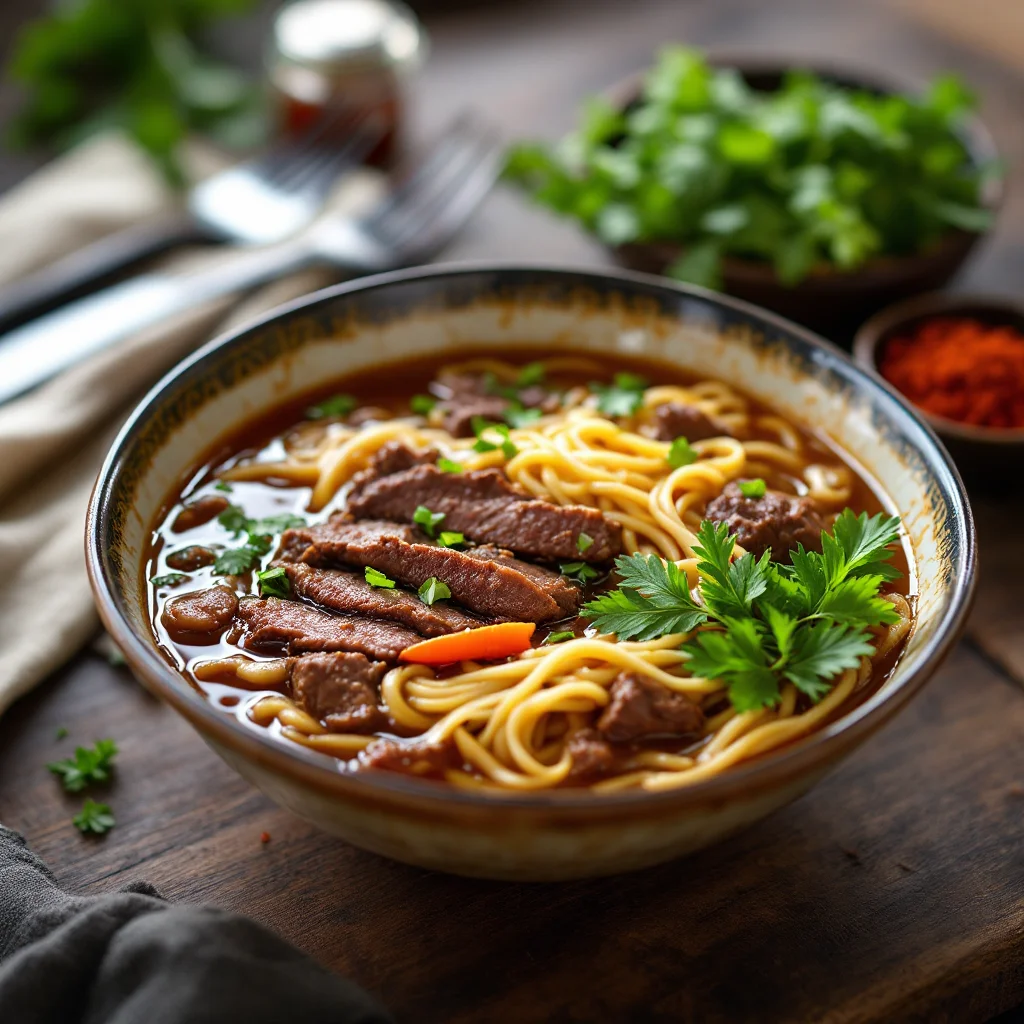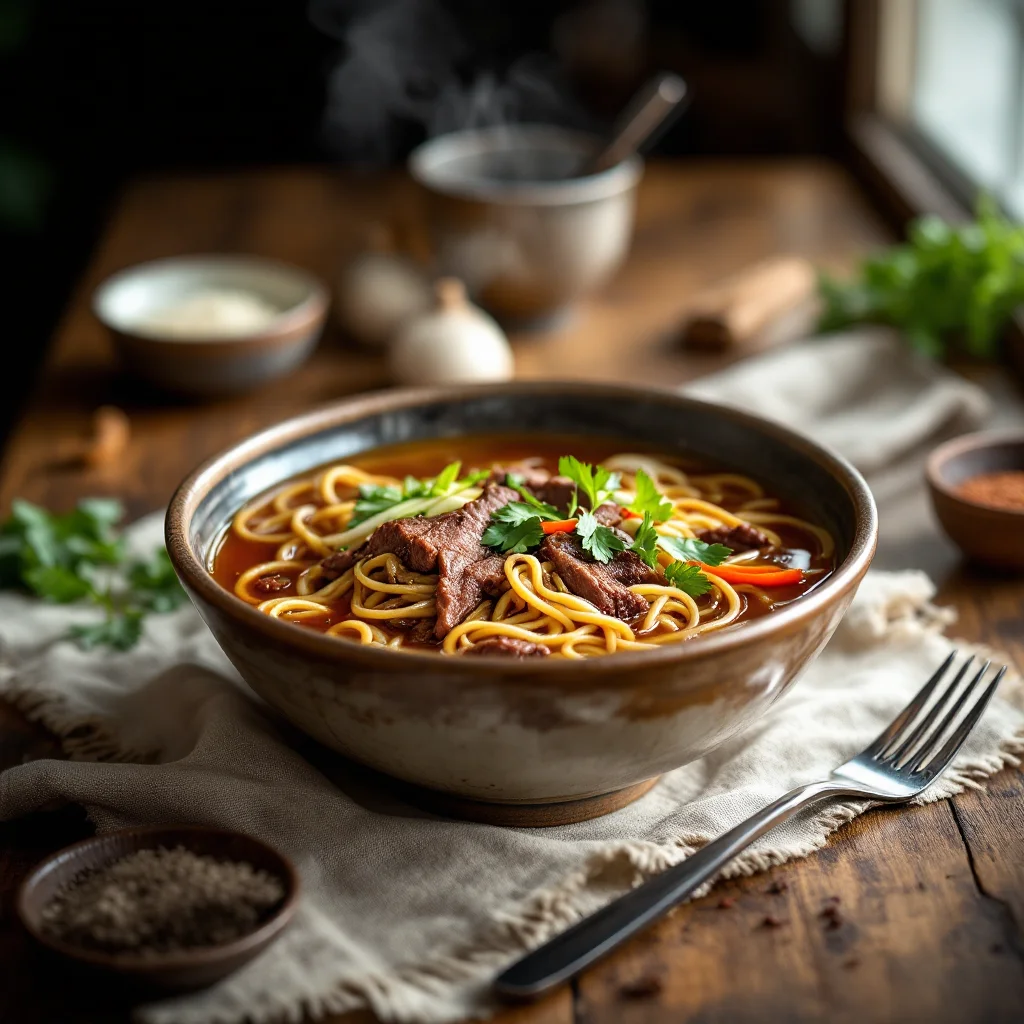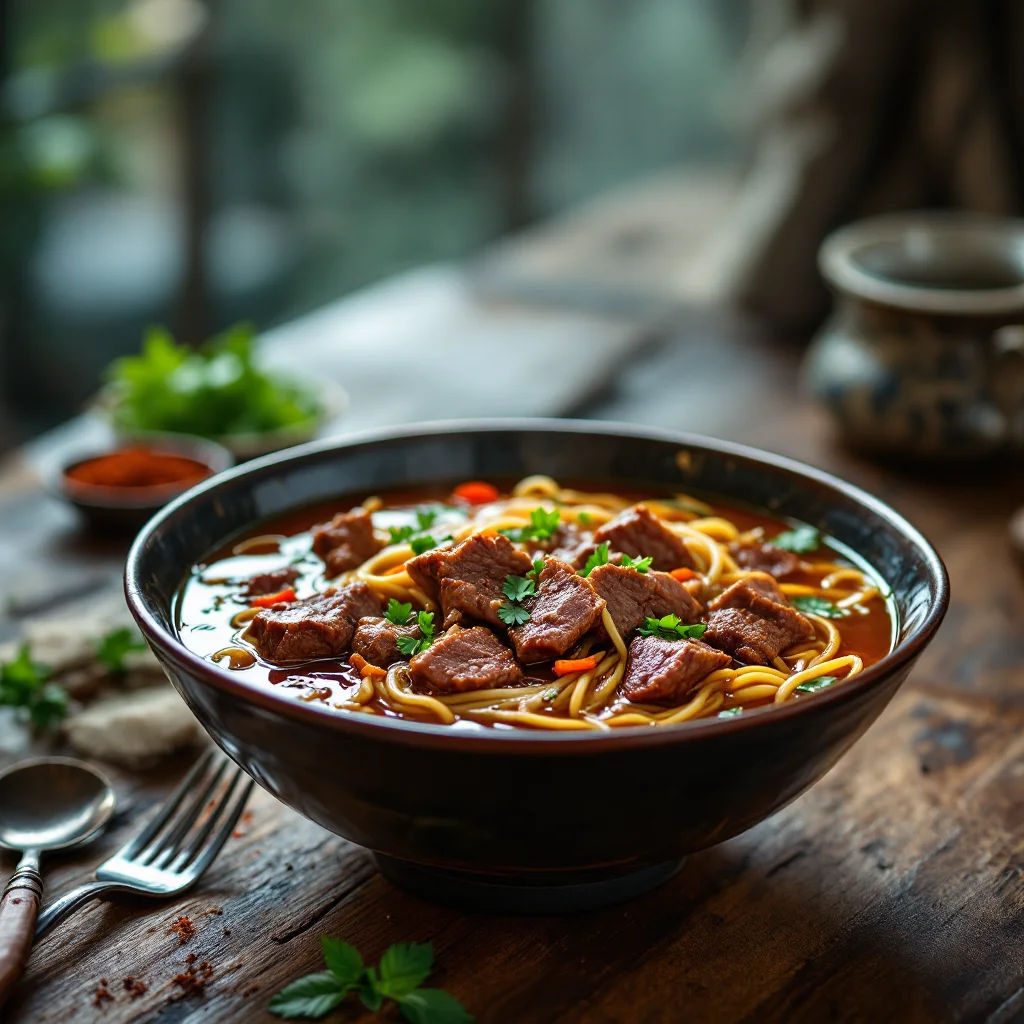introduction:
A steaming bowl of braised beef noodle soup is more than just a satisfying meal; it’s a symbol of centuries-old culinary tradition, cultural exchange, and the universal appeal of comfort food. With its tender chunks of beef, chewy noodles, and aromatic broth, this iconic dish has captured the hearts and palates of people across Asia and beyond. From street food stalls to fine dining, braised beef noodle soup is now a beloved staple in kitchens worldwide.
A Rich Historical Tapestry
The origins of braised beef noodle soup can be traced back to China’s northern and central regions, where hearty, warming dishes were essential during cold winters. The dish’s evolution mirrors the history of Chinese cuisine itself, with early versions appearing as far back as the Tang Dynasty (618-907 CE). However, it was in Taiwan where the soup achieved its most celebrated form.
In the late 1940s, many mainland Chinese immigrants brought their culinary traditions to Taiwan, where they adapted their recipes to local ingredients and preferences. The Taiwanese version of braised beef noodle soup became a distinct style, characterized by its rich, flavorful broth and melt-in-your-mouth beef. Today, it is considered Taiwan’s unofficial national dish, with annual festivals dedicated to finding the best beef noodle soup in the country.https://recipesofangels.com/3-ingredient-mandarin-orange-cake/

Table of Contents
The Symphony of Ingredients
The Heart of the Dish: The Beef
The foundation of an exceptional braised beef noodle soup lies in the choice of beef. Cuts like beef shank and brisket are preferred for their rich marbling and their ability to become tender when slow-cooked. These cuts contain collagen and connective tissue, which break down during braising, resulting in a rich, flavorful broth and tender meat that practically falls apart at the touch of a fork.
The Soul: The Broth
The broth is a complex, harmonious blend of ingredients, including soy sauce, rock sugar, and aromatic spices such as star anise, cinnamon, bay leaves, and Sichuan peppercorns. Fresh ingredients like ginger, garlic, and scallions are added to deepen the flavor. The result is a broth that’s simultaneously savory, sweet, and aromatic, with layers of complexity that evolve with each spoonful.
The Foundation: The Noodles
Traditional wheat noodles, often hand-pulled, are the classic choice for braised beef noodle soup. Their chewy texture and ability to absorb the rich, flavorful broth while maintaining their structural integrity make them the perfect match for the hearty beef and aromatic soup. Noodle thickness can vary by region, with some preferring delicate, thin strands, while others opt for thicker, more substantial noodles that hold up to the rich broth.
Mastering the Cooking Process
The creation of braised beef noodle soup requires patience and skill. The beef is typically seared to develop a flavorful crust before being slowly braised for several hours. This slow cooking process allows the meat to become fork-tender while infusing the broth with its rich flavors.
The broth-making process is equally crucial. Spices are often dry-toasted before being added to the broth to release their essential oils, ensuring maximum flavor. The broth is then simmered for hours, sometimes up to six, to allow all the ingredients to meld together, creating a deep and complex flavor profile.
Regional Variations and Global Adaptations
Taiwanese Style
The Taiwanese version of braised beef noodle soup features a clearer broth with a pronounced beef flavor, often enhanced with tomatoes and Asian pickled mustard greens. The beef is typically cut into larger chunks and braised until it’s melt-in-your-mouth tender.
Sichuan Interpretation
In Sichuan, the dish takes on a more intense heat profile, incorporating the region’s famous málà (numbing and spicy) flavors. Chili oil and Sichuan peppercorns add heat and a numbing sensation to the broth, giving it a distinctive, bold flavor that’s a hallmark of Sichuan cuisine.
Global Innovations
As braised beef noodle soup has spread around the world, creative adaptations have emerged. In the United States, for instance, some variations incorporate local vegetables like celery and carrots, while Korean versions may feature kimchi as a garnish. These regional twists highlight the dish’s versatility and its ability to evolve in new culinary environments.
Health Benefits and Modern Appeal
Beyond its comforting qualities, braised beef noodle soup also offers significant nutritional benefits. The beef provides protein and essential amino acids, while the bone broth contains collagen and minerals that are beneficial for joint health. The addition of vegetables contributes fiber, vitamins, and antioxidants, making this dish a well-rounded meal.
Modern variations cater to diverse dietary needs, such as:
- Gluten-free versions using rice noodles
- Vegetarian adaptations featuring mushrooms and tofu
- Low-sodium options with modified broth recipes
These variations ensure that braised beef noodle soup remains a popular and adaptable dish for various dietary preferences.

Cultural Significance and Social Impact
In Chinese culture, noodles symbolize longevity and good fortune, and braised beef noodle soup often appears at family gatherings, festivals, and celebrations. The dish represents the union of generations through food, embodying the importance of tradition, family, and shared experiences. In Taiwan, the soup has even become a source of pride and friendly competition, with the country hosting annual beef noodle festivals, where restaurants compete for the title of the best beef noodle soup.
Tips for Home Preparation
Essential Techniques:
- Choose the right cut of beef: Opt for beef shank or brisket, which are ideal for braising.
- Toast spices: Dry-toast your spices to release their oils and enhance the broth’s flavor.
- Simmer low and slow: The key to a rich and flavorful broth is slow simmering over several hours.
- Cook noodles separately: To avoid soggy noodles, cook them separately and add them to the soup just before serving.
Storage and Preparation:
You can prepare the beef and broth in advance and store them separately in the refrigerator for up to three days. This makes braised beef noodle soup an excellent dish for meal prepping or entertaining.
Frequently Asked Questions (FAQs)
Q: What’s the best cut of beef for braised beef noodle soup?
A: Beef shank or brisket are ideal due to their marbling and connective tissue, which break down during cooking to create tender meat and a rich, flavorful broth.
Q: How long should the beef be braised?
A: Braise the beef for 2-3 hours, or until it becomes fork-tender. The cooking time may vary depending on the cut and size of the meat.
Q: Can I make this dish in advance?
A: Yes, you can prepare the beef and broth 1-3 days ahead and store them separately in the refrigerator. The flavors actually improve with time.
Q: What makes Taiwanese beef noodle soup different from other versions?
A: The Taiwanese version typically features a clearer broth, tender braised beef, and often includes tomatoes and pickled mustard greens for added flavor.
Q: How can I make the broth more flavorful?
A: Toast your spices before adding them to the broth, use a combination of regular and dark soy sauce, and ensure a long, slow simmer to extract maximum flavor.
Q: What are good vegetable additions to the soup?
A: Traditional options include bok choy, spinach, pickled mustard greens, and blanched bean sprouts. Garnish with fresh cilantro and green onions for added freshness.
Conclusion
Braised beef noodle soup is a comforting, flavorful dish that brings together rich history, tender beef, chewy noodles, and a savory broth. Originating in China and perfected in Taiwan, this iconic meal has become a global favorite. Whether enjoyed in its traditional form or with creative adaptations, it continues to capture the hearts of food lovers everywhere.
Whether you’re making it at home or enjoying it at a restaurant, braised beef noodle soup is a timeless dish that celebrates culture, tradition, and the simple joys of a delicious meal. So why not try it for yourself and experience the magic of this soul-warming soup?
